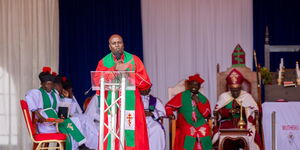Unknown to many Kenyans, hidden deep in the history and foundation of State House, Nairobi, is some currency that was buried more than 113 years ago in 1907.
The building was designed by architect Herbert Baker who seconded his protégé Arthur James Scott Hutton to supervise the construction of what came to be Kenya’s most guarded place.
During a past interview in Kenya, one of Hutton's daughters, Barbara Margaret, revealed that his father had a habit of burying contemporary objects under the foundations of his projects among them State House in Nairobi.
She recalled that together with her sisters, Joan and Marigold, their father made them clean some coins that they placed in the foundation of State House.
Hutton often chose to bury currency underneath the buildings to serve as a time capsule.
Architects in those days had a practice of preserving articles and records of contemporary culture for perusal by scientists and scholars of the distant future.
Hutton had learned the practice from Baker who is the brains behind the design of Nairobi School.
In 1929, during the construction of the school, Baker buried a copy of the East African Standard newspaper (The Standard) and some coins at the foundation.
The two architects are also credited for the design and construction of State House Mombasa, Nairobi Law Courts and Jamhuri High School.
Time capsules are not exclusive to architecture. In 2000, a time capsule was erected by the International Fund for Animal Welfare (IFAW) at Nairobi Safari Walk .
Buried beneath the stone is a glass capsule containing messages from many people in Kenya about what they hope to improve for animals in 50 years.
According to JKUAT urban design professors Muhoro Teckla, Munala Gerryshom and Mugwima Njuguna, Nairobi's iconic architecture has elements of cultural, artistic, and religious significance enriched by foreign influences such as Baker and Hutton.
Iconic buildings are heavily influenced by colonial features which are then modified by local culture, climate, tradition, materials and technology.
One of the most visible European influences was the classical revival style architecture which can be seen at City Hall. The classical revival style mostly signified authority like the Kenya Railways Headquarters, and the former High Court building that now houses the Supreme Court.












